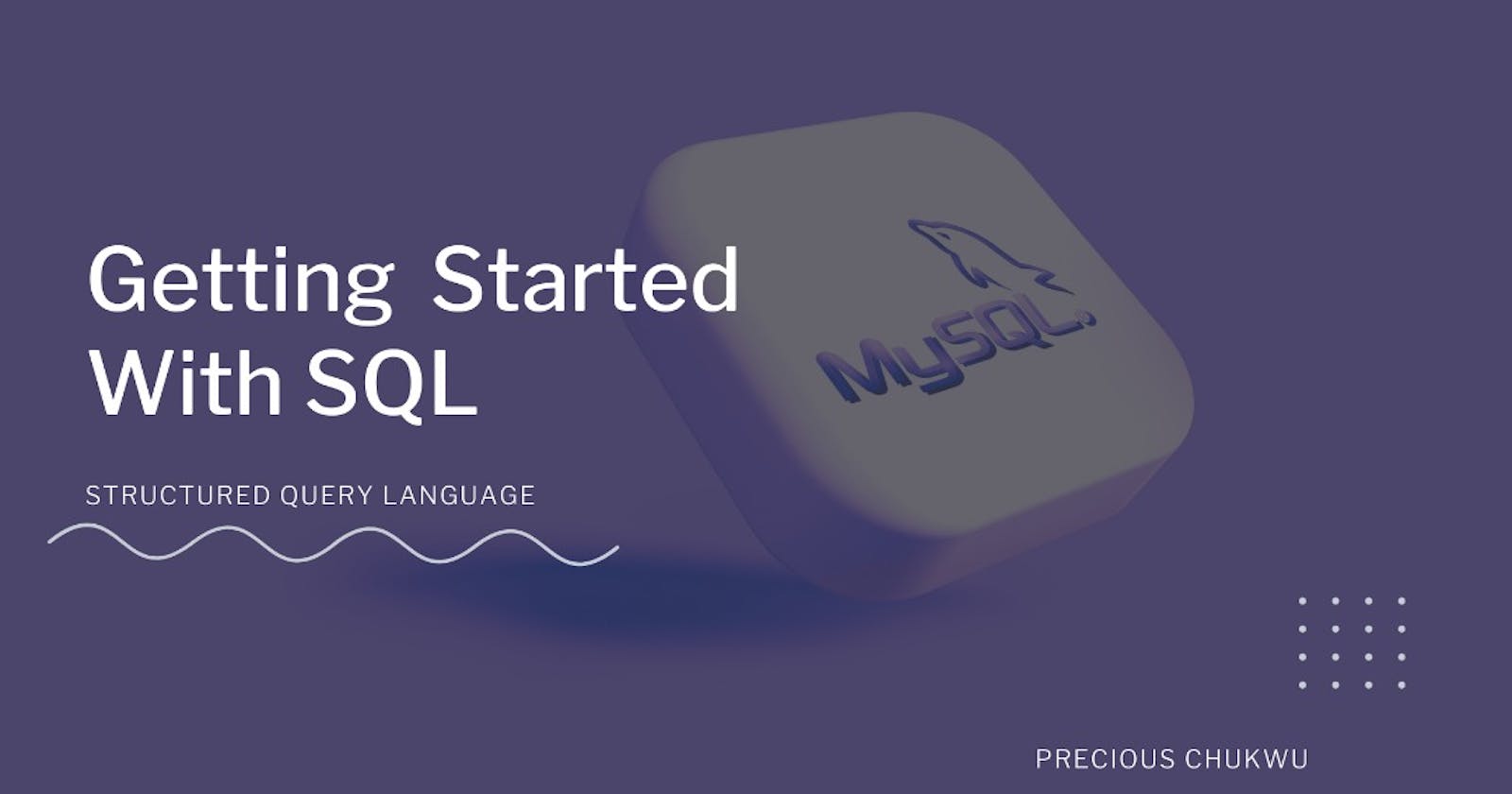INTRODUCTION
SQL, which stands for "structured query language," is a standard language for database access. We live in a world where a lot of data is generated every second, whether it’s the number of search queries on Google or the number of pictures and profiles on Facebook. Data is growing in quantity, and more organizations are beginning to understand the importance of making data-driven decisions. Still, not everyone fully understands the power of generating insights from the data we have around us.
With such power, businesses can become more profitable and efficient, understand their target markets better, and stop fraud and other criminal activity. With all the data we have at our disposal, SQL is a principal tool used to decipher big data, and in this article, I will explain how to get started with SQL programming.
WHAT IS SQL
SQL is a standard language that is accepted globally for managing data in relational databases (RDBMS). It is one of the coding languages that is consistently in demand when dealing with data. It’s used for storing, retrieving, and manipulating data kept in a relational database. SQL stands for "Structured Query Language,” and it is pronounced as "see'qwl" or “or ess-que-el." The origins of SQL can be traced back to the 1970s. Dr Edward F. Codd, while working with IBM, described the relational model of databases in 1970. Using the idea brought by Codd, IBM began to research ways to implement it, resulting in the production of the prototype of the first RDMS in 1978, which was referred to as the "System/R project." As part of the project, IBM produced the first relational database, known as Structured English Query Language (SEQUEL), which is an ancestor of today’s modern database query languages and was later renamed to SQL. SQL was standardized by the American National Institute (ANSI) in 1986. In this section, we have looked at the meaning of SQL and its history. In the next section, we will look into more things relating to SQL.
WHAT ARE SQL CONSTRAINTS
SQL constraints are used to specify rules for data in a table. They can limit the kind of data that can be inserted into a table while also helping to increase the reliability and accuracy of the data present in a database. The constraints that are commonly used in SQL are as follows.
Default Constraint - it assigns a value to a column when no value is specified by the user.
Not Null Constraint - it ensures a column doesn’t have a null value.
Unique Constraint - it ensures that every value is different from the other.
Primary Key - it is a unique identifier for each record present in the table.
Foreign Key - it is a unique identifier for a record in another table of the same database.
Check Constraint - it ensures that the values present in the column satisfy a specific condition
SQL LANGUAGE ELEMENTS
SQL consists of statements that start with keywords and commands. Understanding them would help you get a good grip on the language.
Expressions - This component is capable of producing scaler values and also produces tables that contain rows and columns of data.
Predicates - They can be used to limit the effects of queries and statements.
Queries - They are responsible for retrieving data based on the criteria specified and they are one of the most important elements in SQL.
Statements - They are used for controlling program flow, transitions, sessions, diagnostics, or connections.
SYNTAX OF SQL
The syntax of SQL is governed by the American National Standard Institute (ANSI) and the International Organization for Standardization (ISO). Like all programming languages, SQL is governed by a set of guidelines and rules as to how the commands are to be used. This standard is in place to enable SQL to be usable in different databases. All SQL statements start with keywords like SELECT INSERT UPDATE DELETE ALTER DROP CREATE USE SHOW These statements all end with a semicolon (;). Some syntax in SQL are;
SELECT
SELECT column_name(s) FROM table_name;
WHERE
SELECT column_name(s) FROM table_name WHERE condition;
AND / OR
SELECT column_name(s)
FROM table_name
WHERE condition
AND / OR condition;
ALTER TABLE
ALTER TABLE table_name
DROP COLUMN column_name
BETWEEN
SELECT column_names(s)
FROM table_name
WHERE column_name
BETWEEN value1 AND value2
CREATE DATABASE
CREATE DATABASE database_name
CREATE TABLE
CREATE TABLE table_name
(column_name1 datatype,
column_name2 datatype,
Column_name3 datatype…..)
CREATE INDEX**
CREATE INDEX index_name
ON table_name (column_name)
CREATE VIEW
CREATE VIEW view_name AS
SELECT column_name(s)
FROM table_name
WHERE condition
DELETE
DELETE FROM table_name
WHERE some_column = some_value
IN
SELECT column_name(s)
FROM table_name
WHERE column_name
IN(value1,value2)
HAVING
SELECT column_name,aggregate_function(column_name)
FROM table_name
WHERE column_name operator value
GROUP BY column_name
HAVING aggregate_function(column_name)operateor value
GROUP BY
SELECT column_name, aggregate_function
FROM table_name
WHERE table_name
GROUP BY column_name
ORDER BY
SELECT column name(s)
FROM table_name
ORDER BY column_name ASC/DESC
WHAT IS SQL USED FOR
SQL is used to define and manipulate data stored in a data database. It helps users to understand and describe there data. It makes data stored in a relational database accessible to users. It creates the possibilities of creating databases and tables and also dropping them. It’s used to create function, views and procedure in a database. It allows users to define and set permissions on procedures, table and views.
SQL CAREERS IN DEMAND
SQL is one of the most consistently in-demand coding languages that you can study. The demand occupies almost half of job postings related to data. Here are some careers you can embark on with a skill in SQL;
Data Analyst - Data analysts sift through vast amounts of data to get significant conclusions from it.
Data Scientist - Data scientists are experts in creating and enhancing new methods for analyzing data in order to get new insights.
Business Analyst - A business analyst examines data to gather knowledge that may be used to make decisions for the company.
Database Developer - Database developers are constantly extending and improving the SQL code used to access databases.
Database Administrator -Database administrators are in charge of making sure that the business is using the proper technologies to store and retrieve its data.
Software Engineer - Knowing SQL is essential for software engineers because they frequently work with databases.
SQL DATABASES SYSTEM YOU SHOULD KNOW
Users can communicate with databases using a user interface to retrieve data from database systems. Here are several databases you should be familiar with:
MY SQL- It is an open-source relational database that is free to individuals and businesses. Among completely controlled database formats for SQL-based management, MySQL is one of the most widely used. Oracle Corporation has now bought the C and C++-based open-source project that it initially began as.
POSTGRE SQL - It is a free open-sourced database management system known for its free licensing model. PostgreSQL builds resilient databases that can support and analyze complex and massive amounts of data by combining the conventional table-based approach with user-defined objects.
MICROSOFT SQL SERVER - It is one of the most often used DBMS in SQL for creative management solutions. It runs on all major versions of the Windows operating system.
ORACLE DATABASE- Oracle Corp. offers a multi-model relational database management system that can accommodate various workloads. Data storage and online transaction processing are two common uses of this DBMS type in SQL.
SQ LITE - SQLite is one that is structurally similar to a C library. It is incorporated into other programs to improve their storage capacities. It's frequently used as the on-disk file format in programs for cataloging and financial analysis, among other things.
NO SQL - NoSQL databases are effective when handling huge distributed data collections. Compared to relational databases, they are better able to address big data performance challenges. Additionally, they excel at processing data from cloud virtual servers and huge unstructured data volumes.
MONGO DB - It is a free open sourced non-relational database management system and it can be used for applications that use both structured and unstructured data.
MARIA DB - It is a SQL-based database management system that is similar to MySQL DBMS.
WHERE TO LEARN MY SQL
The availability of the internet has given you a variety of options when looking for a place to study. There are many possibilities available when attempting to choose the ideal course or book to read. You can learn SQL on YouTube, where a variety of experts are available to teach you both the fundamentals and more complex concepts. The best part is that you can pick and choose who you want to learn from. Second, to expand your expertise, look for classes on websites like Udemy and Coursera. I recommend Alex the Analyst's channel since I have personally tried taking some of his YouTube classes.
WHERE TO ASK FOR HELP LEARNING SQL
Asking for assistance when learning a programming language like SQL is common, and there are online platforms that can provide just that. Question-and-answer websites like Quora, Reddit, StackExchange, and StackOverflow might be helpful when learning SQL because it's common to run into problems and need support.
HOW LONG DOES IT TAKE TO LEARN SQL
The speed at which someone can learn will determine whether something takes a few days or a few months to learn. However, learning SQL can be completed quickly and in a few weeks. While learning, completing projects along the way speeds up your learning process and aids in learning more quickly.
CONCLUSION
We discussed the definition of SQL and its background in this article. To offer you a fundamental understanding of how SQL operates in a database, we also discussed its limitations, vocabulary, and syntax. Furthermore, we discussed the applications of SQL, possible occupations you could pursue with this expertise, and different databases where this programming language could be applied. Then we discussed where to learn SQL and how to get assistance if you ever run into issues. With this information, hopefully, you can move forward with your SQL learning. I hope this was helpful, and I wish you well.

